
Two blank cheques: are Ontario and B.C. copying the homework?
Governments of the two provinces have eerily similar plans to give themselves new powers to...
On islands known for their monumental works of art, the monumental trees that make that art possible are getting harder and harder to find.
Centuries old red and yellow cedar trees, the essential raw materials that make Haida poles, canoes, bentwood boxes, masks, intricately woven hats and so much more possible, are being logged at a steady clip.
And once again on Haida Gwaii, there are renewed calls to slow that old-growth logging before it’s too late.
This summer, The Narwhal travelled to Haida Gwaii, the archipelago that made international headlines in the 1980s when members of the Haida Nation blockaded a logging road on Lyell Island — a dispute that catalyzed similar fights for Indigenous rights and forest protection elsewhere in British Columbia.
In the ensuing decades, half of Haida Gwaii’s forests would be protected, a level of conservation unrivalled in most jurisdictions around the world. But the flipside of that protection was to concentrate logging on a smaller land base, allowing the assault on cedar, the tree that the Haida co-evolved with over thousands of years, to continue.
“We really rely on monumental cedars,” says Gwaliga Hart, a Haida artist and carver. “It’s greatly shaped who we are today and really is going to be the thing that defines who we are into the future as well. We don’t want to lose it.”
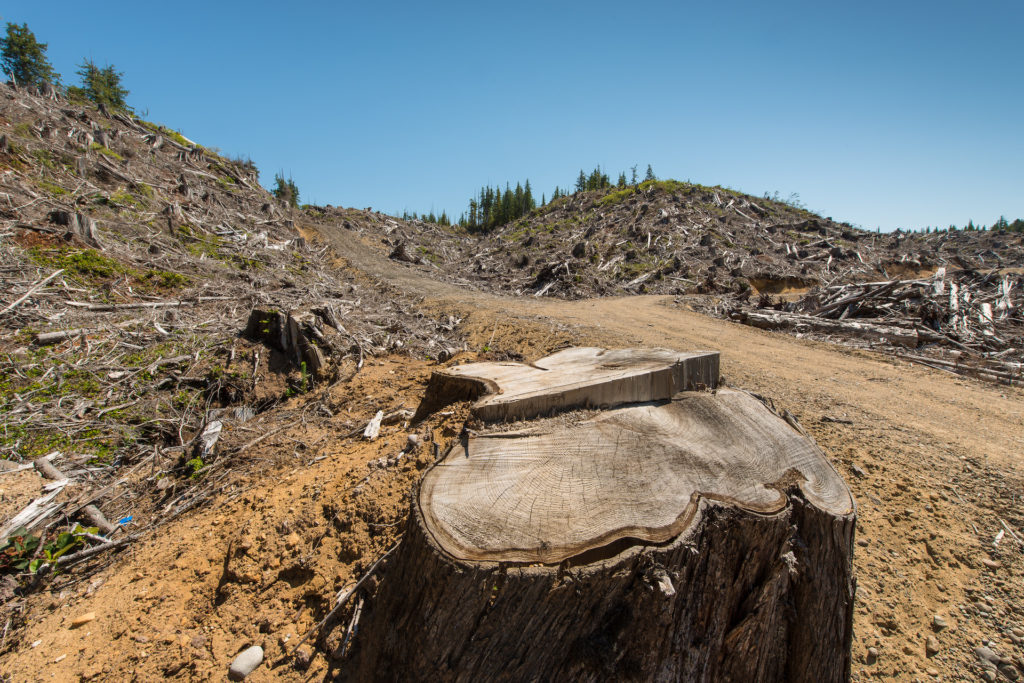
A stump from an ancient cedar tree at a Husby Forest Products logging operation at St’aala Kun — the site of an occupation blocking old-growth logging on Haida Gwaii last year. Photo: Garth Lenz
In 1862, a smallpox epidemic wrought devastation on Haida Gwaii, part of a wave of introduced diseases that killed an estimated 19,000 Haida people, leaving only several hundred survivors.
The advent of industrial forestry a century later advanced swiftly, much like that epidemic, wiping away ancient forests and cedar trees that the Haida had worked with for generations.
The protests at Lyell Island, ensuing court cases, and emerging efforts between Haida and non-Indigenous residents on the islands, solidified opposition to that onslaught and united much of the population in efforts to protect more forests and to try to ensure that local communities benefitted from what logging remained.
Since 2012, under a new co-management committee consisting of both Haida members and members of the provincial government, logging rates on the islands have been held to around 930,000 cubic metres of “timber” per year. For the decade prior to that, the “allowable annual cut” was nearly twice that rate.
Timber is the word typically used by the forest industry to describe trees destined for the chopping block and conversion to building materials.
One cubic metre of timber is equivalent to about one telephone pole’s worth of wood. If that many poles were spaced an average distance apart like you see on most city streets, you could run 930,000 poles from Vancouver to Halifax and back and then do it all over again.

A barge loaded with old-growth logs is towed up Masset Inlet. Many of the logs are from ancient cedar trees and will be processed in Vancouver. Most of the hemlock and spruce logs will be shipped overseas as raw, unprocessed logs. Photo: Garth Lenz
While logging rates have fallen dramatically on Haida Gwaii, one thing remains largely unchanged from the years since industrial forestry began. Virtually every tree logged on the islands is taken away by barge.
If those trees are spruce or hemlock, many end up in the holds of ocean freighters and are shipped overseas for processing, never to enter a mill in B.C., let alone be processed on Haida Gwaii.
If they are prized cedar trees, they are barged off the islands to be turned into lumber, fence posts, panels, shakes or shingles in distant sawmills in the Greater Vancouver area — an ongoing irritant for island residents who for decades have grappled with their islands being a fibre basket mined by others.
“If they were doing it sustainably, using the logs in place on-island, having a mill for value-added products or something of benefit to the Haida Nation, that would be a different thing entirely,” says Steven Lloyd, a health care worker who moved to the islands from Vancouver eight years ago and who frequently watches those barges moving up Masset Inlet, the body of water that cleaves deep into Graham Island, the large island on the north of the archipelago.
With a new annual allowable cut for the islands expected soon, the speculation is that logging rates could be halved again. For some island residents and Haida Nation members like Lisa White it can’t come soon enough.
White is a Haida member who runs an art store in Old Masset. She is part of a family of renowned artists and was among a group of protesters who mounted an occupation at St’aala Kun or Collison Point last year, blocking old-growth logging at the remote site about a 45-minute boat ride from White’s community.
Husby Forest Products, the company whose logging operations were targeted, went to B.C. Supreme Court seeking an injunction against the protesters. According to court documents, the protesters allegedly included three women “armed” respectively with a knife, a rifle and an axe.
In his ruling, Justice Jasvinder Bill Basran noted that while there might be legitimate concerns about aggressive logging of cedar trees, those concerns needed to be addressed through other means, not via “a blockade involving the use of weapons.” If the Council of the Haida Nation had concerns (the council had not organized the protests and was an intervenor in the case), the judge said it needed to seek remedies through the courts.
The blockade ended. But opposition to the logging remains. In many peoples’ minds, the unprotected half of the islands is being logged in a manner that bears no resemblance to the way the Haida themselves worked in the forests for thousands of years.
“I think a whole new approach is needed,” White told The Narwhal. “I think we need to revisit the land-use plan and look at how the Haida used the forest. They used the trees for everything, but they never disrespected the forest. Everything needed respect.”
A year after the blockade, The Narwhal walked with White through an unlogged forest about a 20-minute drive south from her store.
White eventually stopped at a younger cedar tree. A prominent strip of the tree’s bark had been peeled away, exposing the lighter wood underneath. It was one of countless cedars in the forest and others nearby that had portions of their durable, stringy bark harvested for use in weaving and other Haida artworks.
Trees just like this commonly fall in logging operations with comparatively little outcry because they lack the height and grandeur of the old cedar trees that are the raw material for poles and other Haida artworks.
“You need young trees like this for harvesting cedar bark. But they’re not protected because they have to be this big,” White says stretching her arms wide.
A searchable database maintained by the provincial government supports White’s assertions that cedar trees, in particular, are being deliberately targeted for logging on Haida Gwaii.
If all the trees on the islands are considered, just over one-third of them are red cedar trees. Yet in numerous logging operations on the islands, the amount of cedar being logged vastly outpaces the average.
Husby Forest Products has been most aggressive in that regard, and its logging of cedar trees in particular has triggered tensions between members of the Haida Nation and the Delta-based logging company for years. In the last decade alone, 56 per cent of all the trees the company logged were red cedar, and in some years nearly three in every four trees that fell were the iconic species. The Council of the Haida Nation attempted unsuccessfully in B.C. Supreme Court last year to halt Husby’s logging at St’aala Kun on grounds that the company had logged past its legally entitled limits and was on track to take down another 2,700 large cedars.
The provincial government itself isn’t far behind in earning the Haida’s enmity. BC Timber Sales
is a B.C. government agency that auctions blocks of timber. Companies making the highest bids then win the rights to log the trees, in exchange for paying the provincial government the bid price. In block after block auctioned by the provincial agency, the amount of cedar logged has averaged 45 pent in the most recent ten years.
By contrast, Taan Forest, a company owned by the Haida Nation, logged less than the average. While the company is still engaged in the same kind of clear-cut logging operations that have galvanized protests on the islands over the decades, the average amount of cedar trees it logged over the past decade was 28 per cent.
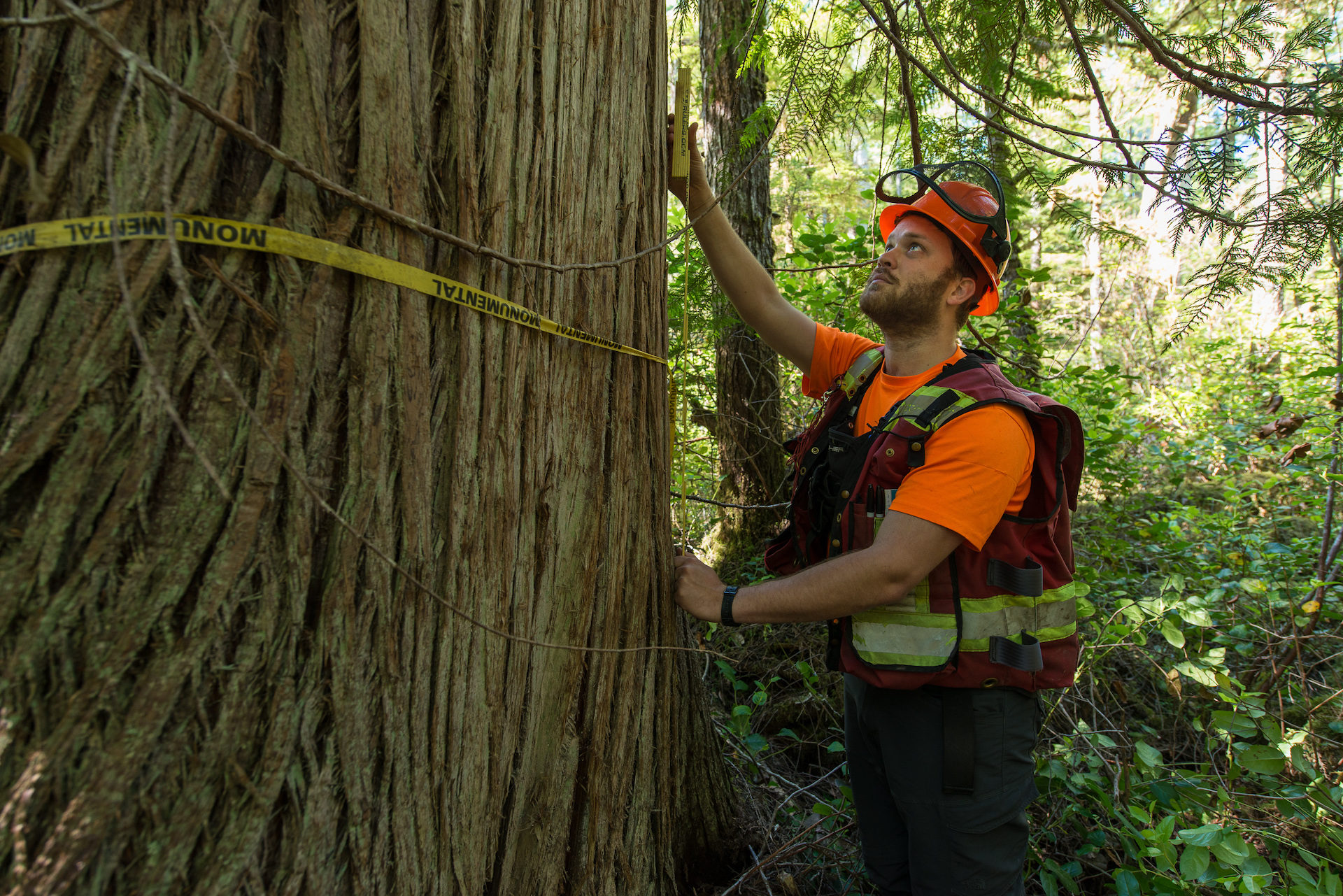
Jeremy Calhoun, a forester with the Council of the Haida Nation, measures a monumental cedar tree in a forest south of Old Massett. Photo: Garth Lenz
Jeremey Calhoun, a forester with the Council of the Haida Nation, says that due to outcries on the islands, the provincial government’s chief forester tried in 2012 to dampen the amount of cedar being logged by telling the companies they should avoid logging more cedar than was there. The move was made, Calhoun said, “to help ensure a continued supply of high economic value timber in the future.”
With evidence in the intervening years that Husby and others failed to do that, a new order came down known as a “hard partition”, that will require companies to hold the line and log no more cedar trees than the average.
But it’s questionable just how tough and effective the new “hard” rule will be. For one, the new rules imposed by Chief Forester Diane Nicholls will not apply to the provincial government’s own BC Timber Sales. And they will not apply to portions of the land that the Haida-owned Taan Forest holds logging rights to either. Logging companies will also still be able to exceed the ceiling on cedar logging over several years, just so long as at the end of five years they are at or below the threshold. And five years, at current logging rates, is a long time.
“What’s happening to the land — the disrespect of the land — is the thing,” White says, explaining her desire for an end to all old-growth logging on the archipelago. “The Haida never clear-cut. They single-cut.”
Dale Lore is a former mayor of Port Clements, a small community at the south end of Masset Inlet, in the heart of Graham Island. For 30 years, he built logging roads for MacMillan Bloedel, a company that dominated logging operations on Haida Gwaii, Vancouver Island and elsewhere on B.C.’s coast before becoming a ghost, just like the millions of old-growth trees it had cut.
On a sunny June day, Lore drives his pickup truck up to one of the highest points of land on Graham Island. The entire journey is along a road he built from Juskatla, where MacMillan Bloedel once had a base of operations, to an outlook nearly 1,000 metres above the Queen Charlotte lowlands to the north and the Skidegate plateau to the south. The road was built, because much of the valley bottom old-growth forests were logged, Lore says, leaving MacMillan Bloedel little choice but to move up or move out.
Looking down below, Lore said that 94 per cent of the original old-growth forest to the south on Graham Island is gone. To the north, perhaps half remains, and anything that is not protected — including St’aala Kun — is getting hit hard.
To give a sense of what is at risk of being lost elsewhere on the archipelago, Lore takes visitors to a ridge about 800 metres from the Yakoun river.
In the cool, shaded old-growth forest with its towering trees Lore points to some of the known 50 red cedar trees in this tract of forest alone that were carefully selected and individually cut down by Haida people. In eight cases, beside or near the stumps of those trees are old logs of a length and mass ideally suited to large ocean-going Haida canoes or smaller vessels used for trips nearer shore. In the other 42 cases, the canoe-length logs were gone, but it was clear that the felled trees were used as the stock for canoes because between the ancient stumps and the top portions of the felled trees were empty spaces of canoe length.
“The canoe was the tricycle, the bicycle, the sportscar, the touring sedan, the fishing boat, the war vessel, the trading vessel. It was everything,” Lore says. “You had all these different canoes and you literally needed 30 to 40 canoes per village.”
In another tract of forest, a log with the rough shape and length of a canoe sits adjacent to a stump cut sometime in the latter half of the mid-19th century. The initial, rudimentary shaping of the canoe’s bow and stern is evident along with the flattening of the top of the log in preparation for its hollowing out.
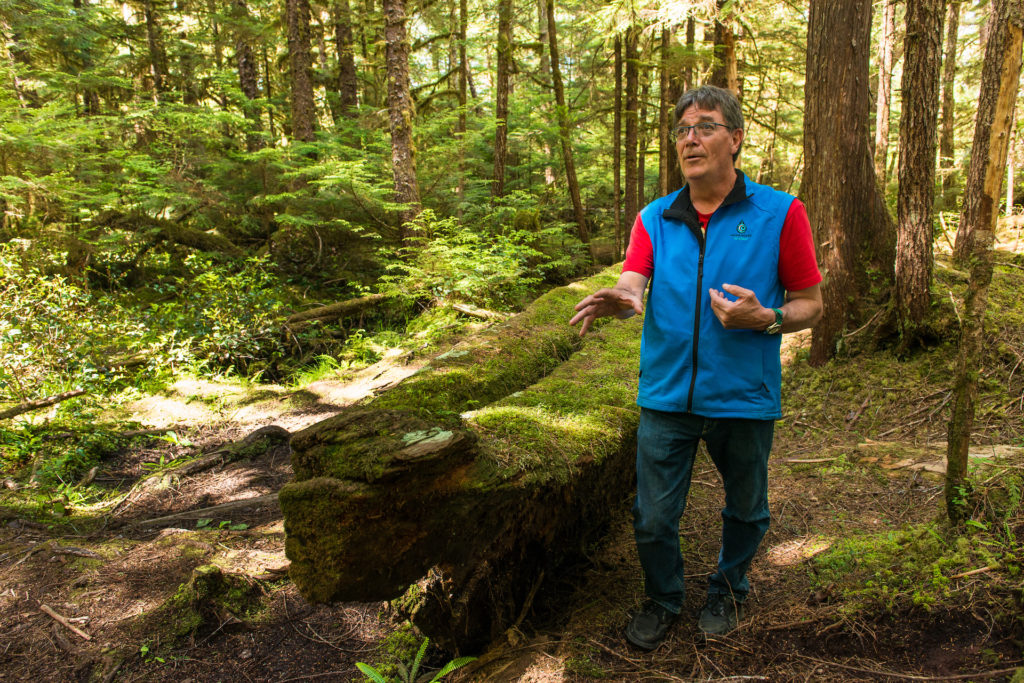
Dale Lore stands beside a moss-covered, partially shaped Haida canoe in the forest near the Yakoun River. The canoe was being shaped in the woods and work likely stopped in 1862, the year of the great smallpox epidemic. Photo: Garth Lenz
The partially carved canoe log and others like it resting in the quiet woods are a powerful sign of all that was lost when the 1862 smallpox epidemic swept through and likely killed the canoe’s carvers. But it also symbolizes something else, Gwaliga Hart says, and that is just how intelligently the Haida people used forests over the course of thousands of years, taking only what was needed, when it was needed and adding value to it right then and there.
“It’s the industrialization of things, the outside pressures and demands and the market prices defined by off-island economies, that have really been the driving force of how fast logging operations are happening here,” Hart says.
As part of a precedent-setting co-management regime on Haida Gwaii, rules were created to protect trees that are so intimately intertwined with Haida culture.
The most important of those rules applies to “monumental” cedar, the centuries-old giants that are the perfect trees from which to make poles and massive canoes. Any such trees found in forests that might be logged are to be left standing in islands of unlogged forest.
Other rules are in place to limit the logging of other very large cedar trees that do not meet the “monumental” definition, but that are big enough to be ideal candidates for use by Haida craftsmen and artists. Or, when the logging of such trees does take place, that Haida artists are given first rights to use those trees.
In the forests at St’aala Kun, Calhoun and three other men who have done monitoring work for the Council of the Haida Nation — Sean Brennan, Gerry Morigeau and Jonas Prevost — showed The Narwhal some of the ways those rules are being broken.
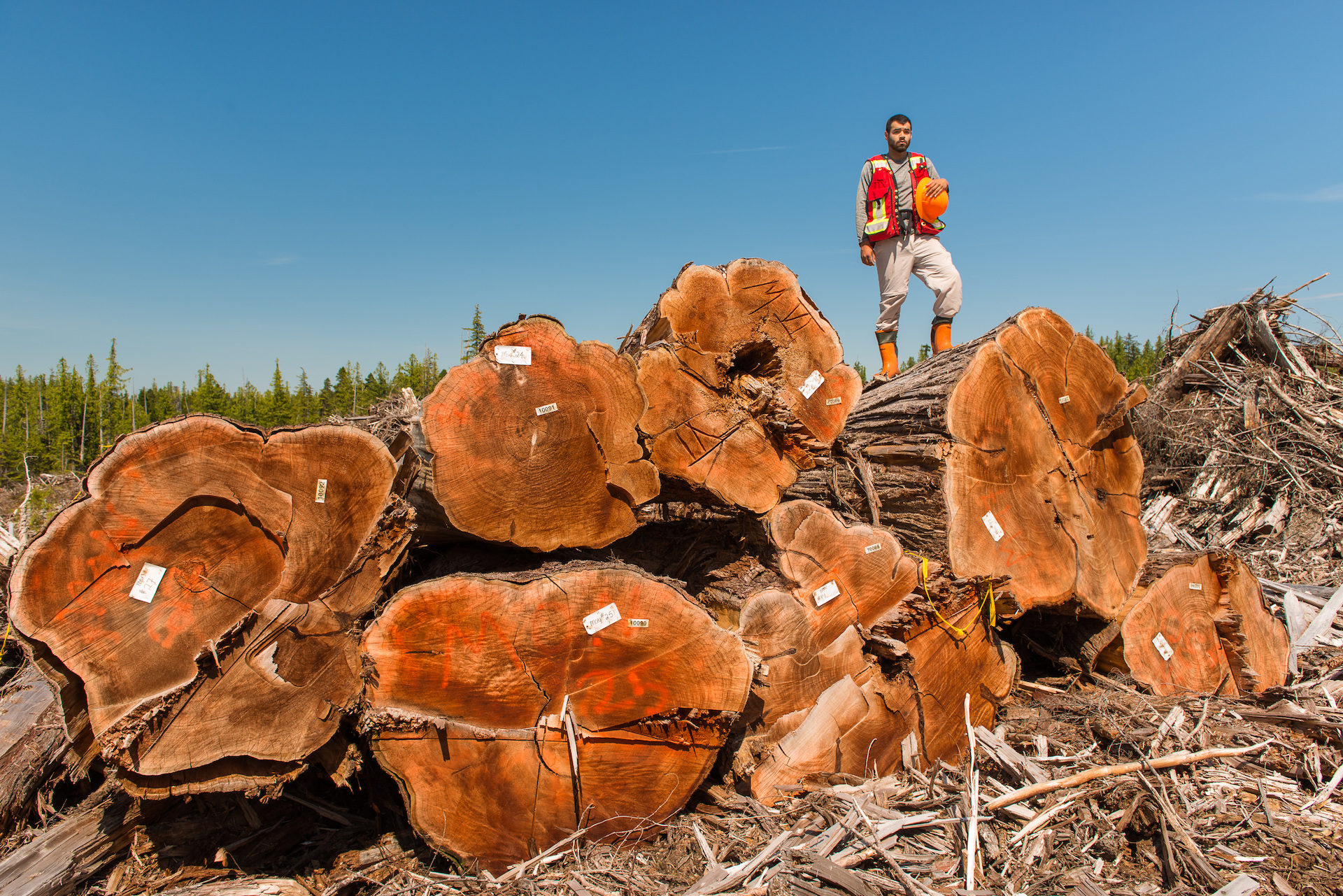
Jonas Prevost stands on a pile of massive cedar logs at a Husby Forest Products logging operation that triggered protests at St’aala Kun last year. Photo: Garth Lenz
In one unlogged old-growth forest, numerous massive cedar trees all seemed to fall magically along a proposed road right-of-way that Husby Forest Products proposed to clear. Large, monumental cedar had not been identified as such. Others had been measured and initially identified as monumental, then ordered remeasured and found to have magically fallen just below the critical benchmark measurement. Still others showed signs of the numbers spray-painted on their trunks being rubbed out to obscure their true size.
Morigeau chuckled grimly while walking through the forest, saying it didn’t take much detective work to figure out what was going on. “It’s like kindergarten CSI,” he said.
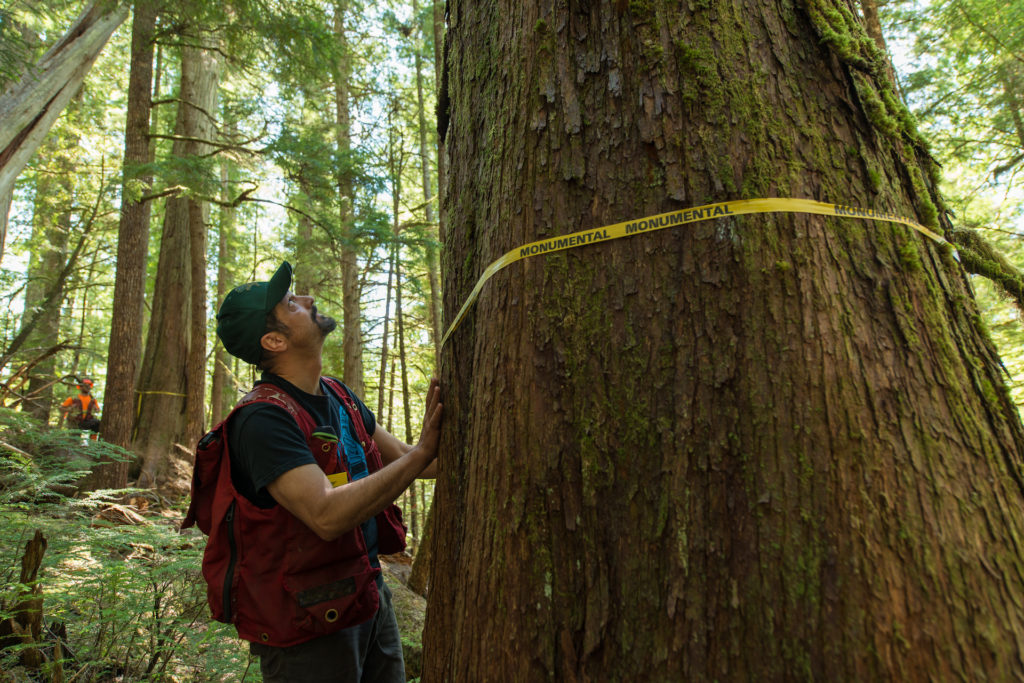
Gerry Morigeau inspects a monumental cedar in an old-growth forest at St’aala Kun, where Husby Forest Products has proposed building a logging road. Photo: Garth Lenz
Prevost called it “blatant disregard” for the rules, adding: “They’re going out of their way to change their numbers and change their evidence.”
Brennan, who has done pre-logging surveys for both the Council of the Haida Nation and logging companies said cedar is clearly driving logging company profits and the companies want to log as much of it as possible with the fewest restrictions.
If a surveyor comes back having marked an entire cedar stand for protection or flagged too many as monumental, he or she will hear about it, Brennan says.
“There’s often a request from somebody higher up, whoever’s overseeing the operations: ‘Go back in and take a closer look, because you guys are finding too much stuff.’ It’s capitalism 101.”
Later, after driving down a network of hot, dusty logging roads, Calhoun pulled a pickup truck up to a giant pile of extremely large cedar logs that had been left by Husby at the side of the road. About the same time that Lisa White and others were protesting at St’aala Kun last year, Calhoun and others discovered that many large cedar trees had not been identified before logging commenced and were now down.
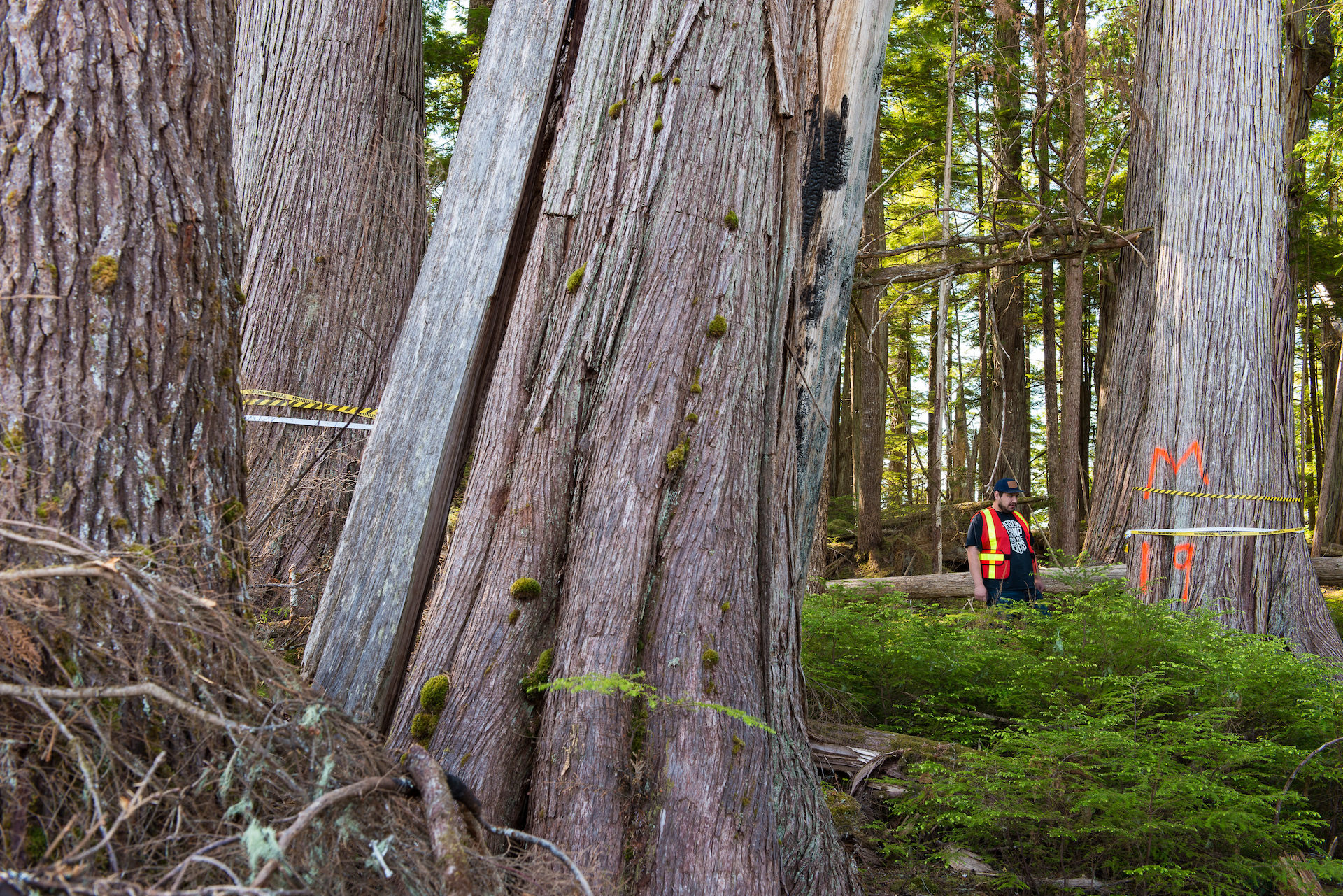
Sean Brennan, a Haida artist who also is trained to survey proposed logging blocks and identify cedar trees that should be protected, walks through a small stand of monumental cedar trees near St’aala Kun. Photo: Garth Lenz
The logs are now in a weird limbo land. Haida artisans can pay Husby the cost of logging the trees plus a mark-up through a “cultural access program” administered by the provincial forests ministry. Or, if no expressions of interest are forthcoming, Husby will presumably barge them away.
“Tell me if you’ve ever heard of anything more colonial than that,” Morigeau says.
Back in the truck, Morigeau says that despite the successful fights to conserve extensive tracts of Haida Gwaii, eradication of old-growth forests continues.
“If we didn’t allow this old-growth cedar to leave these islands, without some form of processing, I think there would be entrepreneurs lining up and saying: ‘What can we do for you?’ I’ve watched the forest industry here. The amount of jobs per volume has just dwindled to almost nothing,” Morigeau says. “I think it’s time to put the brakes on and just reassess why we’re doing what we’re doing. If you go anywhere else in the world where they’re logging thousand-year-old old-growth forests, they’re doing it in the cover of darkness with guns.”
The Narwhal contacted Husby vice-president Rob Sandberg by phone and later submitted several written questions regarding the company’s cedar logging and allegations that it had misidentified monumental cedar trees. The company declined to provide answers.
Around the time Lisa White was protesting at St’aala Kun, her brother and Haida artist and carver Christian White was looking for a suitable cedar log for his current project — a peace pole commissioned by the Council of the Haida Nation that will be delivered across Hecate Strait, the body of water separating Haida Gwaii and the mainland, for raising in Heiltsuk territory.
He searched a long time.
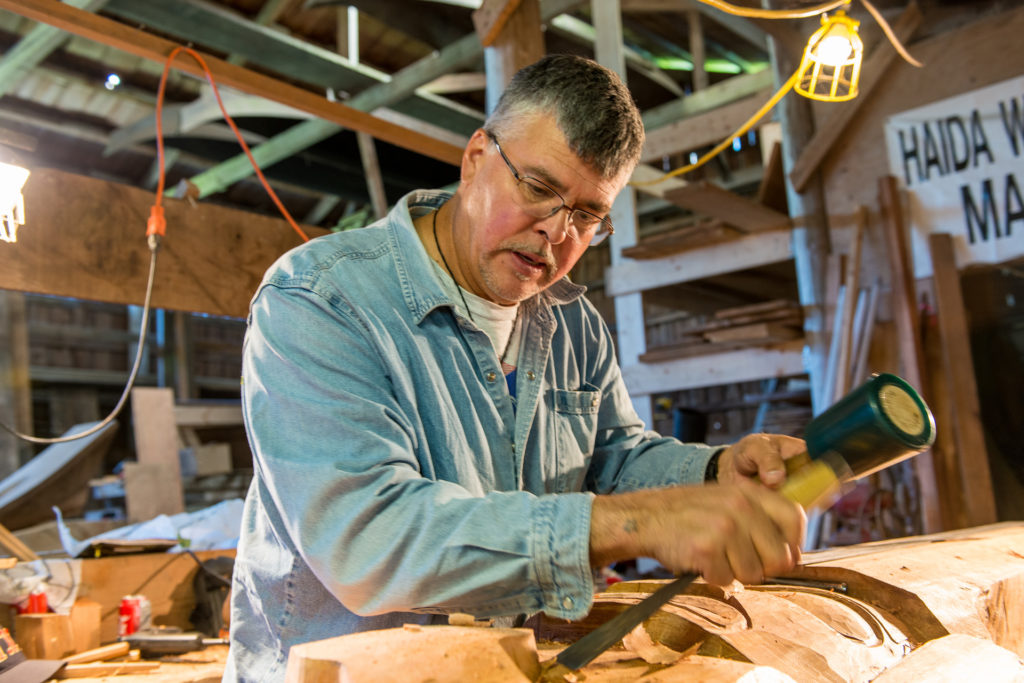
Accomplished Haida carver Christian White works on a reconciliation pole at his workshop in Old Massett. White says the monumental cedar logs needed to make great works of Haida art are harder and harder to find. Photo: Garth Lenz
To make a monumental work of art, you need a monumental tree. Trees suitable for poles must be old. Their trunks must be large in circumference and the trunks can’t twist. Lastly, only trees whose first branches are far above the ground will do because branches produce knots. To meet those standards, a cedar must grow for hundreds of years if not a thousand or more.
After eight months looking, White thought he had what he wanted. But the log was later damaged. Eventually, the company whose logging operations his sister and others had protested against, took him to see some large cedar trees that it had cut down.
“Husby took us to where the monumentals were. I looked at several along the road in piles. I was able to get a good look at it and give it my approval,”
The pole that White and his brother Derek are working on is 10 metres long, and is being carved in the round, meaning that there are designs all around the pole, which necessitates turning it frequently to complete the work and ensure a balancing of elements.
The big, old trees aren’t there like they used to be, White says.
“Canoe and pole trees take anywhere from 300 to 1,000 years to reach this size. That’s why it’s so important for the Council of the Haida Nation to protect these trees.”
If enough of those trees are preserved and parceled out to Haida artists as needed, multiple generations can make a good living producing art, White says. He ought to know. He’s been carving for 45 years, and in that time he’s probably only gone through about 20 cedar logs.
“We could have become loggers,” he says, putting his hammer and chisel down for a moment. “But we went back to the carving art. And we made a good living, I guess.”
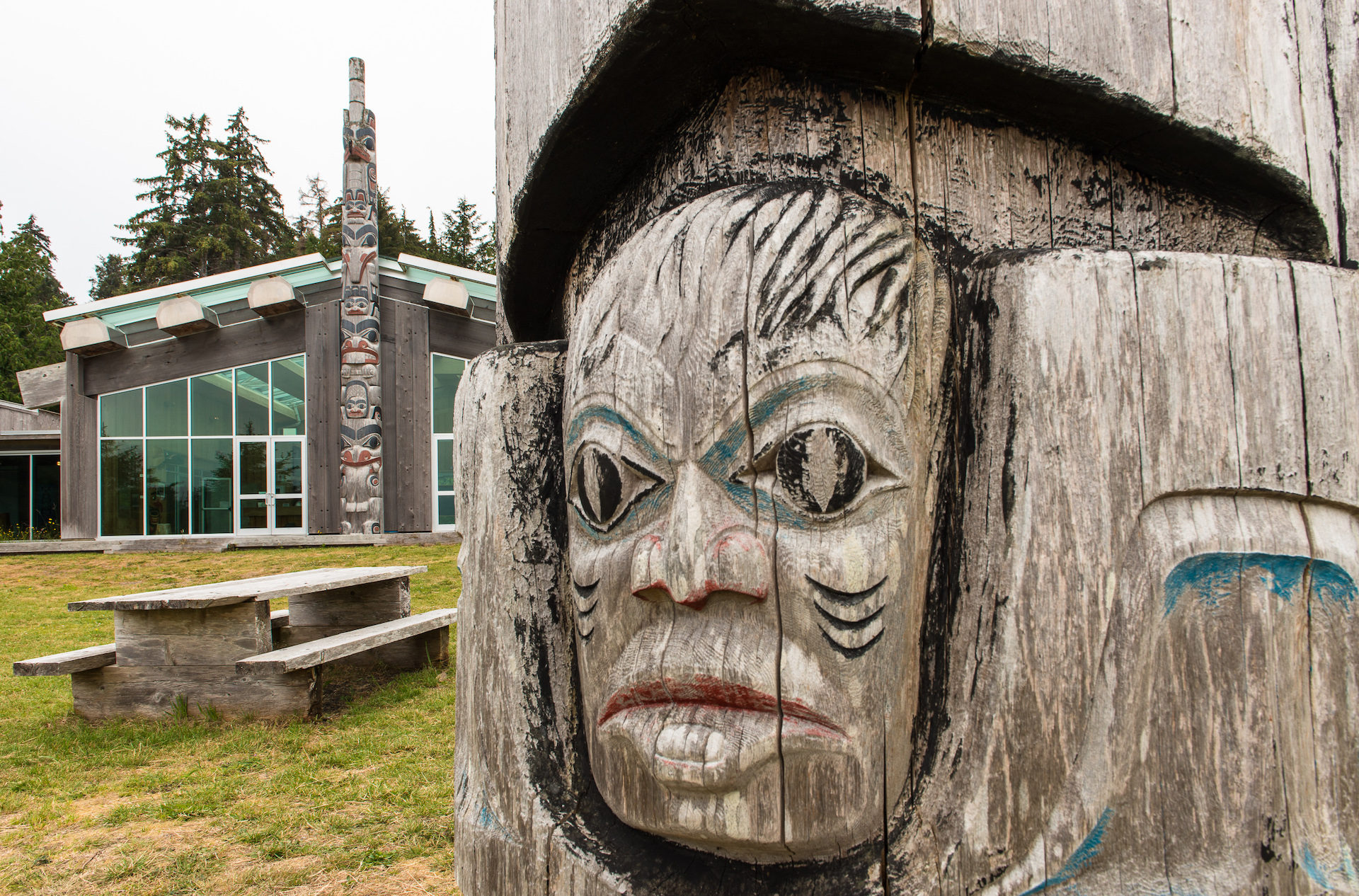
Poles at the museum in Skidegate on Haida Gwaii. Photo: Grath Lenz
Two days after speaking with White at his woodshop in Old Massett, an exhibit opened at the Haida Gwaii museum in Skidegate. The new exhibit chronicled just a fraction of the 12,000 Haida artifacts known to be housed in museums around the world, works of art that Christian White and others are actively trying to repatriate to their homeland. Untold numbers more likely reside in private hands.
The exhibit’s central display is 1,300 photographs papering the walls in one room and depicting artworks, many of which were taken from, or sold under duress by, Haida people during or after the great epidemics.
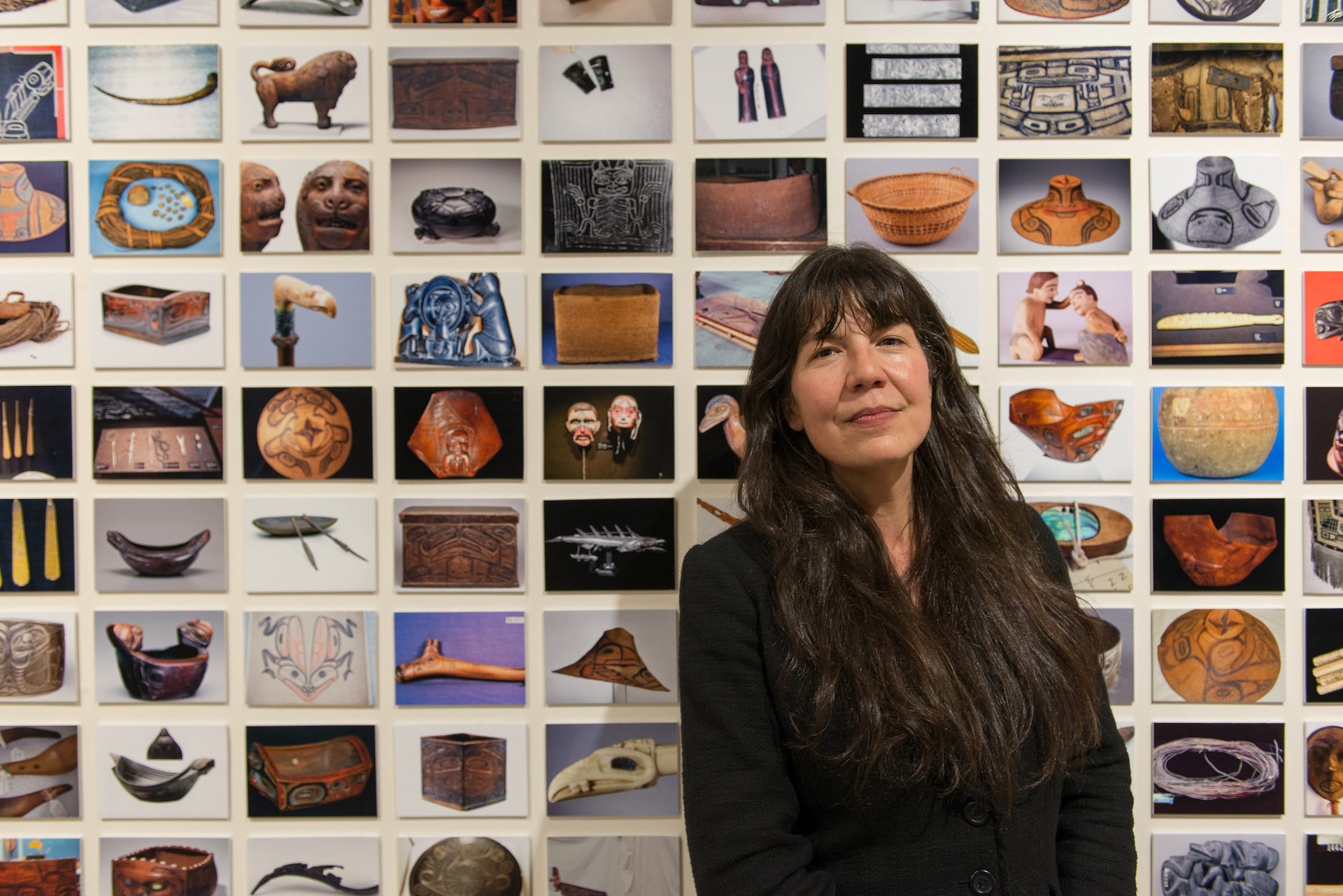
Nika Collison, director and curator of the Haida Gwaii Museum, stands in front of a wall of photographs depicting some of the more than 12,000 works of Haida art that are known to be in museum collections around the world and that the Haida want back. Photo: Garth Lenz
The photographs capture the details of a finely woven hat of yellow cedar bark, an intricately rendered bear’s face outlined in white buttons and sewn onto a red and black cloth jacket, a necklace of burnished blue stone, a sculpture of two Haida in a canoe carved from fine-grained argillite, a black sedimentary rock found on the islands, and much, much more.
At some point it becomes too much to take in, which in the mind of the museum director and curator, Nika Collison, is intentional.
“It’s overwhelming. And that’s the point,” Collison says. “It’s a drop in the bucket. Thirteen hundred individual pieces. And we know of over 12,000. Think about that.”
One element common to many of the pictures on the wall is that they were carved, shaped or woven using cedar wood or bark. The association between the Haida and cedar goes back 6,500 years, Collison says, adding that no one should take losing that association lightly.
“If we don’t have our trees,” Collison says, “we’d be like everybody else.”
This article was produced in partnership with the Small Change Fund.
Get the inside scoop on The Narwhal’s environment and climate reporting by signing up for our free newsletter. On a warm September evening nearly 15...
Continue reading
Governments of the two provinces have eerily similar plans to give themselves new powers to...

Katzie First Nation wants BC Hydro to let more water into the Fraser region's Alouette...

Premier David Eby says new legislation won’t degrade environmental protections or Indigenous Rights. Critics warn...
